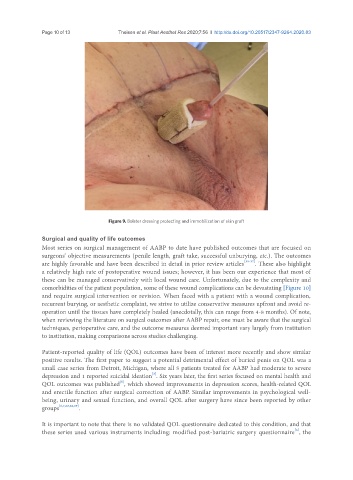Page 654 - Read Online
P. 654
Page 10 of 13 Theisen et al. Plast Aesthet Res 2020;7:56 I http://dx.doi.org/10.20517/2347-9264.2020.83
Figure 9. Bolster dressing protecting and immobilization of skin graft
Surgical and quality of life outcomes
Most series on surgical management of AABP to date have published outcomes that are focused on
surgeons’ objective measurements (penile length, graft take, successful unburying, etc.). The outcomes
are highly favorable and have been described in detail in prior review articles [35-37] . These also highlight
a relatively high rate of postoperative wound issues; however, it has been our experience that most of
these can be managed conservatively with local wound care. Unfortunately, due to the complexity and
comorbidities of the patient population, some of these wound complications can be devastating [Figure 10]
and require surgical intervention or revision. When faced with a patient with a wound complication,
recurrent burying, or aesthetic complaint, we strive to utilize conservative measures upfront and avoid re-
operation until the tissues have completely healed (anecdotally, this can range from 4-8 months). Of note,
when reviewing the literature on surgical outcomes after AABP repair, one must be aware that the surgical
techniques, perioperative care, and the outcome measures deemed important vary largely from institution
to institution, making comparisons across studies challenging.
Patient-reported quality of life (QOL) outcomes have been of interest more recently and show similar
positive results. The first paper to suggest a potential detrimental effect of buried penis on QOL was a
small case series from Detroit, Michigan, where all 5 patients treated for AABP had moderate to severe
[3]
depression and 1 reported suicidal ideation . Six years later, the first series focused on mental health and
[5]
QOL outcomes was published , which showed improvements in depression scores, health-related QOL
and erectile function after surgical correction of AABP. Similar improvements in psychological well-
being, urinary and sexual function, and overall QOL after surgery have since been reported by other
groups [6,7,22,38,39] .
It is important to note that there is no validated QOL questionnaire dedicated to this condition, and that
[6]
these series used various instruments including: modified post-bariatric surgery questionnaire , the

